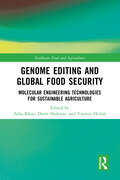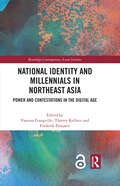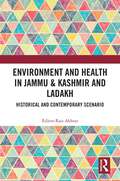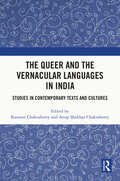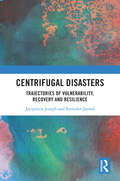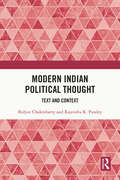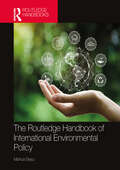- Table View
- List View
Genome Editing and Global Food Security: Molecular Engineering Technologies for Sustainable Agriculture (Earthscan Food and Agriculture)
by Zeba Khan Durre Shahwar Yasmin HeikalWith the rapid increase in the global population and changing climatic impacts on agriculture, this book demonstrates how genome editing will be an indispensable technique to overcome ongoing and prospective agricultural challenges. This book examines the role of genome editing in improving crop yields and contributing to global food security. It summarizes a range of genome editing techniques and discusses the roles they can play in producing a new generation of high-yielding, climate-ready crops. This includes site-specific nucleases, precision genome engineering, clustered regularly interspaced short palindromic repeats, and bioinformatics. It showcases how these gene editing techniques can tailor plants to not only increase yield-related traits but to also make them better suited to their environment and to be resistant to pests and extreme climatic events, such as droughts. The book also examines genome editing regulations and policies, the commercialization of genome-edited crops, and biosafety and biosecurity concerns. Overall, this book reveals and showcases how genome editing can improve crop resilience and production to address current and future agricultural challenges and alleviation of global food security concerns. This book will be of great interest to students and scholars of agricultural science, crop and plant science, genome editing, sustainable agriculture, biotechnology, and food security.
Design, Displacement, Migration: Spatial and Material Histories (Routledge Research in Design History)
by Sarah A. Lichtman Jilly TraganouDesign, Displacement, Migration: Spatial and Material Histories gathers a collection of scholarly and creative voices—spanning design, art, and architectural history; design studies; curation; poetry; activism; and social sciences––to interrogate the intersections of design and displacement. The contributors foreground objects, spaces, visual, and material practices and consider design’s role in the empire, the state, and various colonizing regimes in controlling the mass movement of people, things, and ideas across borders, as well as in social acts that resist forced mobility and immobility, or enact new possibilities. By consciously surfacing echoes, rhymes, and dissonances among varied histories, this volume highlights local specificity while also accounting for the vectors of displacement and design across borders and histories. Design, Displacement, Migration: Spatial and Material Histories shows displacement to be a lens for understanding space and materiality and vice versa, particularly within the context of modernity and colonialism. This book will be of interest to scholars working in design history, design studies, architectural history, art history, urban studies, and migration studies.
National Identity and Millennials in Northeast Asia: Power and Contestations in the Digital Age (Routledge Contemporary Asian Societies)
by Vanessa Frangville Thierry Kellner Frederik PonjaertThis book examines how the young in Northeast Asia engage with the political, especially in terms of the production, reformulation, or contestation of their national identities. Through case studies covering China, Japan, South Korea, North Korea and Taiwan, the contributions provide a study of the online spaces where youth engage with current debates regarding national identities. The book also unpacks the distinctive forms of expression and negotiation of national identities favoured by younger generations across Northeast Asia and asks questions specifically raised by their political mobilisation. For example, how their public mobilisation for a given cause has forced them to rethink their place in national and global communities. This book will be a valuable resource for scholars and students of East Asian culture and politics, media studies and youth studies. The Introduction of this book is freely available as a downloadable Open Access PDF at http://www.taylorfrancis.com under a Creative Commons Attribution-Non Commercial-No Derivatives (CC-BY-NC-ND) 4.0 license.
Design, Displacement, Migration: Spatial and Material Histories (Routledge Research in Design History)
by Sarah A. LichtmanDesign, Displacement, Migration: Spatial and Material Histories gathers a collection of scholarly and creative voices—spanning design, art, and architectural history; design studies; curation; poetry; activism; and social sciences––to interrogate the intersections of design and displacement. The contributors foreground objects, spaces, visual, and material practices and consider design’s role in the empire, the state, and various colonizing regimes in controlling the mass movement of people, things, and ideas across borders, as well as in social acts that resist forced mobility and immobility, or enact new possibilities. By consciously surfacing echoes, rhymes, and dissonances among varied histories, this volume highlights local specificity while also accounting for the vectors of displacement and design across borders and histories. Design, Displacement, Migration: Spatial and Material Histories shows displacement to be a lens for understanding space and materiality and vice versa, particularly within the context of modernity and colonialism. This book will be of interest to scholars working in design history, design studies, architectural history, art history, urban studies, and migration studies.
National Identity and Millennials in Northeast Asia: Power and Contestations in the Digital Age (Routledge Contemporary Asian Societies)
by Vanessa Frangville Thierry Kellner Frederik PonjaertThis book examines how the young in Northeast Asia engage with the political, especially in terms of the production, reformulation, or contestation of their national identities. Through case studies covering China, Japan, South Korea, North Korea and Taiwan, the contributions provide a study of the online spaces where youth engage with current debates regarding national identities. The book also unpacks the distinctive forms of expression and negotiation of national identities favoured by younger generations across Northeast Asia and asks questions specifically raised by their political mobilisation. For example, how their public mobilisation for a given cause has forced them to rethink their place in national and global communities. This book will be a valuable resource for scholars and students of East Asian culture and politics, media studies and youth studies. The Introduction of this book is freely available as a downloadable Open Access PDF at http://www.taylorfrancis.com under a Creative Commons Attribution-Non Commercial-No Derivatives (CC-BY-NC-ND) 4.0 license.
Visual Methods of Inquiry: Images as Research
by Kerry Freedman Richard SiegesmundVisual Methods of Inquiry: Images as Research presents qualitative researchers in the social sciences with the benefits, applications, and forms of visual research methods. It includes a wide variety of images to illustrate the many uses of visual methods for social research. Contemporary visual culture theory and practice offers wide-ranging opportunities for methodological advancement in the social sciences. This book covers the basics of image use in visual research methods and explores how these methods can be used effectively in social science research by surveying the conditions of visual forms, materials, and concepts, and the ways these represent and influence social conditions, phenomena, beliefs, and actions. It examines the roles and processes of interpretation in visual research and discusses ethical considerations that arise when using visual research methods. Students of social science and the visual arts will find this book useful in expanding and improving their methods of inquiry. Artists and researchers already familiar with visual methods will find that this book clarifies the ways the visual works in various research contexts and provides helpful language to describe and explain those methods.
Environment and Health in Jammu & Kashmir and Ladakh: Historical and Contemporary Scenario
This engaging book presents an insightful look into the contributing factors that have shaped the modern public health system in Jammu & Kashmir and Ladakh. Reflecting on the historical, socio-economic, and contemporary scenario of environment and public health, this book presents chapters that discuss the role of spatial patterns of diseases, health-risk patterns, contributions of medical missionaries in health services in Kashmir, changing disease ecology of Leh, and traditional medical therapy in Ladakh, among others. This book also examines the cholera ecology in Kashmir during the 19th century, and the significance of Kangri ・ a portable traditional heat source ・ in cultural studies, economics, and cancer research. It investigates the role of traditional knowledge in the medical therapy of rural areas of Ladakh and the impact of urbanization on the quality of human health in Srinagar City. Besides, this book examines iodine deficiency disorders and the extension of vector-borne diseases. The essays also probe into the rising mental health concerns in post-pandemic Kashmir. This book will be useful for students, researchers, and teachers of physical geography, human geography, environmental studies, public health, and health sciences. It will also be of interest to political geographers, sociologists, policymakers, and those interested in the issues related to health and environment in the region.
Remaking Indigeneity in the Amazon: Christianity, Colonization and the State
by Esteban RozoDrawing on archival and ethnographic work, this book analyses how indigeneity, Christianity, and state-making became intertwined in the Colombian Amazon throughout the 20th century. At the end of the 19th century the state gave Catholic missionaries tutelage over Indigenous groups and their territories, but, in the case of the Colombian Amazon, this tutelage was challenged by evangelical missionaries that arrived in the region in the 1940s with different ideas of civilization and social change. Indigenous conversion to evangelical Christianity caused frictions with other actors, while Indigenous groups perceived conversion to evangelical Christianity as way of leverage with settlers. This book shows how evangelical Christianity shaped new forms of indigeneity that did not coincide entirely with the ideas of civilization or development that Catholic missionaries and the state promoted in the region. Since the 1960s, the state adapted development policies and programs to Indigenous realities and practices, while Indigenous societies appropriated evangelical Christianity in order to navigate the changes brought on by colonization and state-formation. This study demonstrates that not all projects of civilization were the same in Amazonia, nor was missionization of Indigenous groups always subordinate to the state or resource extraction.
Visual Methods of Inquiry: Images as Research
by Kerry Freedman Richard SiegesmundVisual Methods of Inquiry: Images as Research presents qualitative researchers in the social sciences with the benefits, applications, and forms of visual research methods. It includes a wide variety of images to illustrate the many uses of visual methods for social research. Contemporary visual culture theory and practice offers wide-ranging opportunities for methodological advancement in the social sciences. This book covers the basics of image use in visual research methods and explores how these methods can be used effectively in social science research by surveying the conditions of visual forms, materials, and concepts, and the ways these represent and influence social conditions, phenomena, beliefs, and actions. It examines the roles and processes of interpretation in visual research and discusses ethical considerations that arise when using visual research methods. Students of social science and the visual arts will find this book useful in expanding and improving their methods of inquiry. Artists and researchers already familiar with visual methods will find that this book clarifies the ways the visual works in various research contexts and provides helpful language to describe and explain those methods.
Environment and Health in Jammu & Kashmir and Ladakh: Historical and Contemporary Scenario
by Editor-Rais AkhtarThis engaging book presents an insightful look into the contributing factors that have shaped the modern public health system in Jammu & Kashmir and Ladakh. Reflecting on the historical, socio-economic, and contemporary scenario of environment and public health, this book presents chapters that discuss the role of spatial patterns of diseases, health-risk patterns, contributions of medical missionaries in health services in Kashmir, changing disease ecology of Leh, and traditional medical therapy in Ladakh, among others. This book also examines the cholera ecology in Kashmir during the 19th century, and the significance of Kangri ・ a portable traditional heat source ・ in cultural studies, economics, and cancer research. It investigates the role of traditional knowledge in the medical therapy of rural areas of Ladakh and the impact of urbanization on the quality of human health in Srinagar City. Besides, this book examines iodine deficiency disorders and the extension of vector-borne diseases. The essays also probe into the rising mental health concerns in post-pandemic Kashmir. This book will be useful for students, researchers, and teachers of physical geography, human geography, environmental studies, public health, and health sciences. It will also be of interest to political geographers, sociologists, policymakers, and those interested in the issues related to health and environment in the region.
Remaking Indigeneity in the Amazon: Christianity, Colonization and the State
by Esteban RozoDrawing on archival and ethnographic work, this book analyses how indigeneity, Christianity, and state-making became intertwined in the Colombian Amazon throughout the 20th century. At the end of the 19th century the state gave Catholic missionaries tutelage over Indigenous groups and their territories, but, in the case of the Colombian Amazon, this tutelage was challenged by evangelical missionaries that arrived in the region in the 1940s with different ideas of civilization and social change. Indigenous conversion to evangelical Christianity caused frictions with other actors, while Indigenous groups perceived conversion to evangelical Christianity as way of leverage with settlers. This book shows how evangelical Christianity shaped new forms of indigeneity that did not coincide entirely with the ideas of civilization or development that Catholic missionaries and the state promoted in the region. Since the 1960s, the state adapted development policies and programs to Indigenous realities and practices, while Indigenous societies appropriated evangelical Christianity in order to navigate the changes brought on by colonization and state-formation. This study demonstrates that not all projects of civilization were the same in Amazonia, nor was missionization of Indigenous groups always subordinate to the state or resource extraction.
Tajikistan’s National Epics: Muqanna's Rebellion and The Tajik People's Hero Temur Malik (Asian States and Empires #22)
by Sadriddin AyniSadriddin Ayni (1878-1954) was a Tajik intellectual, regarded by many as one of the most important writers in the country's history. This book provides a translation of two historical monographs by Ayni: Is’yoni Muqanna (Muqanna’s Rebellion) and Qahramoni Khalqi Tojik Temurmalik (The Tajik People’s Hero Temur Malik). These works tell the story of two great Tajik heroes who fought against the Arabs and the Mongols. Besides the translations, the book discusses Ayni’s life and work, highlighting his role, especially through these two monographs, in awakening and strengthening Tajik national consciousness. In addition, the book provides detailed background information on the historical events portrayed in the epics.
Tajikistan’s National Epics: Muqanna's Rebellion and The Tajik People's Hero Temur Malik (Asian States and Empires #22)
by Sadriddin AyniSadriddin Ayni (1878-1954) was a Tajik intellectual, regarded by many as one of the most important writers in the country's history. This book provides a translation of two historical monographs by Ayni: Is’yoni Muqanna (Muqanna’s Rebellion) and Qahramoni Khalqi Tojik Temurmalik (The Tajik People’s Hero Temur Malik). These works tell the story of two great Tajik heroes who fought against the Arabs and the Mongols. Besides the translations, the book discusses Ayni’s life and work, highlighting his role, especially through these two monographs, in awakening and strengthening Tajik national consciousness. In addition, the book provides detailed background information on the historical events portrayed in the epics.
The Queer and the Vernacular Languages in India: Studies in Contemporary Texts and Cultures
This book analyses regional expressions of the queer experience in texts available in the Indian vernacular languages. It studies queer autobiographies and literary and cinematic texts written in the vernacular languages on gay, lesbian, bisexual and transgender issues. The authors outline the specific terms that are popular in the bhashas (languages) to refer to the queer people and discuss any neo coinages/modes of communication invented by the queer people themselves. The volume also addresses the lack of queer representation in certain language communities and the lack of queer interaction in non-metropolitan cities in India. An important contribution to the field of queer studies in India, this timely book will be an essential read for scholars and researchers of gender studies, queer studies, cultural studies, discrimination and exclusion studies, language studies, political studies, sociology, postcolonial studies and South Asian studies.
Centrifugal Disasters: Trajectories of Vulnerability, Recovery and Resilience
by Jacquleen Joseph Surinder JaswalThis book focuses on centrifugal disasters that impact a group of seemingly unconnected people congregated temporarily often by chance, unlike centripetal disasters that strike an extant community of people. In India as well as in South Asia, centrifugal disasters have increased significantly in the last few decades, however the research remains limited as they are often categorized as accidents. The book documents three such major disaster events––26/11 terror attacks and 13/7 blasts in Mumbai, and hospital fire in Kolkata–– and analyses the lived and felt experiences of the survivors and their families. Drawing on the authors’ experience of working with survivors, first responders (police, health workers), as well as policy makers, the book suggests a model of disaster intervention that bridges academia and praxis expertise. Besides providing a rights framework for disaster interventions, it also explores the moral and ethical considerations around disaster interventions. This important book will be of interest to students and practitioners of disaster management including first responders and those working in public management, risk management, hazards and disasters, emergency response, terrorism and political violence. It will also be useful to mental health professionals, social workers, psychologists, civil society organizations, as well as bureaucrats and policy makers.
The Queer and the Vernacular Languages in India: Studies in Contemporary Texts and Cultures
by Kaustav Chakraborty Anup Shekhar ChakrabortyThis book analyses regional expressions of the queer experience in texts available in the Indian vernacular languages. It studies queer autobiographies and literary and cinematic texts written in the vernacular languages on gay, lesbian, bisexual and transgender issues. The authors outline the specific terms that are popular in the bhashas (languages) to refer to the queer people and discuss any neo coinages/modes of communication invented by the queer people themselves. The volume also addresses the lack of queer representation in certain language communities and the lack of queer interaction in non-metropolitan cities in India. An important contribution to the field of queer studies in India, this timely book will be an essential read for scholars and researchers of gender studies, queer studies, cultural studies, discrimination and exclusion studies, language studies, political studies, sociology, postcolonial studies and South Asian studies.
Centrifugal Disasters: Trajectories of Vulnerability, Recovery and Resilience
by Jacquleen Joseph Surinder JaswalThis book focuses on centrifugal disasters that impact a group of seemingly unconnected people congregated temporarily often by chance, unlike centripetal disasters that strike an extant community of people. In India as well as in South Asia, centrifugal disasters have increased significantly in the last few decades, however the research remains limited as they are often categorized as accidents. The book documents three such major disaster events––26/11 terror attacks and 13/7 blasts in Mumbai, and hospital fire in Kolkata–– and analyses the lived and felt experiences of the survivors and their families. Drawing on the authors’ experience of working with survivors, first responders (police, health workers), as well as policy makers, the book suggests a model of disaster intervention that bridges academia and praxis expertise. Besides providing a rights framework for disaster interventions, it also explores the moral and ethical considerations around disaster interventions. This important book will be of interest to students and practitioners of disaster management including first responders and those working in public management, risk management, hazards and disasters, emergency response, terrorism and political violence. It will also be useful to mental health professionals, social workers, psychologists, civil society organizations, as well as bureaucrats and policy makers.
The Routledge History of Fashion and Dress, 1800 to the Present (Routledge Histories)
by Véronique Pouillard Vincent Dubé-SenécalThe time span covered by The Routledge History of Fashion and Dress starts in the nineteenth century, with the aftermath of the consumers’ revolution, and reaches all the way to the present. The fashion and garment industries have been international from the beginning and, as such, this volume looks at the history of fashion and dress through the lenses of both international and global history. Because fashion is also a multifaceted subject with humanagency at its core, at the confluence of thematerial (fabrics, clothing, dyes, tools, and machines) and the immaterial (savoir-faire, identities, images, and brands), this volume adopts a transdisciplinary perspective, opening its pages to researchers from a variety of complementary fields. The chapters in this volume are organized based on their relationship to five fields of study: economics and commerce, politics, business, identities, and historical sources. Paying particular attention to change, the book goes beyond the great fashion capitals and well-known fashion centers and points to the broader geographies of fashion. Particular geographical areas focus on the emergence of new fashion systems and business models, whether they be in Sweden, Bangladesh, or Spain, or on the African continent, considered to be the “new frontier” of the industry. Covering myriad aspects of the subject this is the perfect companion for all those interested in history of dress and fashion in the modern world.
China in European Narratives: Policy, Identity, and Image (Communicating China)
by Li ZhangThis book explores how China, and especially China’s Belt and Road Initiative, is viewed in European media and by European think tanks, thereby uncovering European elites’ views of China. Looking across Europe—the European Union, Western Europe (including the United Kingdom), Central Europe, and Eastern Europe—the book reveals a complex picture, with different views in different places, and with different aspects of China disproportionately emphasized in some places. As China’s importance in the world continues to grow, it is crucial to understand how distorted views of China are shaping international relations.
Modern Indian Political Thought: Text and Context
by Bidyut Chakrabarty Rajendra K. PandeyThis book is an unconventional articulation of the political thinking in India in a refreshingly creative manner in more than one way. Empirically, the book becomes innovative by providing an analytically more grasping contextual interpretation of Indian political thought that evolved during the nationalist struggle against colonialism. Insightfully, it attempts to unearth the hitherto unexplored yet vital subaltern strands of political thinking in India as manifested through the mode of numerous significant socio-economic movements operating side by side and sometimes as part of the mainstream nationalist movement. This book articulates the main currents of Indian political thought by locating the text and themes of the thinkers within the socio-economic and politico-cultural contexts in which such ideas were conceptualised and articulated. The book also tries to analytically grasp the influences of the various British constitutional devices that appeared as the responses of the colonial government to redress the genuine socio-economic grievances of the various sections of Indian society. The book breaks new ground in not only articulating the main currents of Indian political thought in an analytically more sound approach of context-driven discussion but also provokes new research in the field by charting a new course in grasping and articulating the political thought in India. This volume will be useful to the students, researchers and faculty working in the fields of political science, political sociology, political economy and post-colonial contemporary Indian politics in particular. It will also be an invaluable and interesting reading for those interested in South Asian studies.
The Routledge History of Fashion and Dress, 1800 to the Present (Routledge Histories)
by Véronique Pouillard Vincent Dubé-SenécalThe time span covered by The Routledge History of Fashion and Dress starts in the nineteenth century, with the aftermath of the consumers’ revolution, and reaches all the way to the present. The fashion and garment industries have been international from the beginning and, as such, this volume looks at the history of fashion and dress through the lenses of both international and global history. Because fashion is also a multifaceted subject with humanagency at its core, at the confluence of thematerial (fabrics, clothing, dyes, tools, and machines) and the immaterial (savoir-faire, identities, images, and brands), this volume adopts a transdisciplinary perspective, opening its pages to researchers from a variety of complementary fields. The chapters in this volume are organized based on their relationship to five fields of study: economics and commerce, politics, business, identities, and historical sources. Paying particular attention to change, the book goes beyond the great fashion capitals and well-known fashion centers and points to the broader geographies of fashion. Particular geographical areas focus on the emergence of new fashion systems and business models, whether they be in Sweden, Bangladesh, or Spain, or on the African continent, considered to be the “new frontier” of the industry. Covering myriad aspects of the subject this is the perfect companion for all those interested in history of dress and fashion in the modern world.
China in European Narratives: Policy, Identity, and Image (Communicating China)
by Li ZhangThis book explores how China, and especially China’s Belt and Road Initiative, is viewed in European media and by European think tanks, thereby uncovering European elites’ views of China. Looking across Europe—the European Union, Western Europe (including the United Kingdom), Central Europe, and Eastern Europe—the book reveals a complex picture, with different views in different places, and with different aspects of China disproportionately emphasized in some places. As China’s importance in the world continues to grow, it is crucial to understand how distorted views of China are shaping international relations.
Modern Indian Political Thought: Text and Context
by Bidyut Chakrabarty Rajendra K. PandeyThis book is an unconventional articulation of the political thinking in India in a refreshingly creative manner in more than one way. Empirically, the book becomes innovative by providing an analytically more grasping contextual interpretation of Indian political thought that evolved during the nationalist struggle against colonialism. Insightfully, it attempts to unearth the hitherto unexplored yet vital subaltern strands of political thinking in India as manifested through the mode of numerous significant socio-economic movements operating side by side and sometimes as part of the mainstream nationalist movement. This book articulates the main currents of Indian political thought by locating the text and themes of the thinkers within the socio-economic and politico-cultural contexts in which such ideas were conceptualised and articulated. The book also tries to analytically grasp the influences of the various British constitutional devices that appeared as the responses of the colonial government to redress the genuine socio-economic grievances of the various sections of Indian society. The book breaks new ground in not only articulating the main currents of Indian political thought in an analytically more sound approach of context-driven discussion but also provokes new research in the field by charting a new course in grasping and articulating the political thought in India. This volume will be useful to the students, researchers and faculty working in the fields of political science, political sociology, political economy and post-colonial contemporary Indian politics in particular. It will also be an invaluable and interesting reading for those interested in South Asian studies.
The Routledge Handbook of International Environmental Policy
by Mahua BasuThis handbook is a one-stop, comprehensive guide to global initiatives for climate action. It examines policies to tackle climate change and the critical role various organizations play.The volume: Includes in-depth discussion of individual issues related to the environment Highlights global initiatives, negotiations, and international organizations responsible for climate action, protecting marine and freshwater environment, protecting atmosphere and climate, conserving biological diversity, chemicals and wastes management, environmental governance, safeguarding against warfare and disasters Debates on-ground implications of the international policies for the Global South Brings together case studies from across the world Presents a toolkit for environment practitioners to seek sustainable and practicable solutions to problems Includes suggested readings for researchers Brings together primary documents, supportive illustrations, graphs, and maps The handbook will be an essential reference for scholars and researchers of environmental studies, environmental policy and governance, sustainability and resilience. It will also be indispensable for policy makers, think tanks and NGOs.
The Routledge Handbook of International Environmental Policy
by Mahua BasuThis handbook is a one-stop, comprehensive guide to global initiatives for climate action. It examines policies to tackle climate change and the critical role various organizations play.The volume: Includes in-depth discussion of individual issues related to the environment Highlights global initiatives, negotiations, and international organizations responsible for climate action, protecting marine and freshwater environment, protecting atmosphere and climate, conserving biological diversity, chemicals and wastes management, environmental governance, safeguarding against warfare and disasters Debates on-ground implications of the international policies for the Global South Brings together case studies from across the world Presents a toolkit for environment practitioners to seek sustainable and practicable solutions to problems Includes suggested readings for researchers Brings together primary documents, supportive illustrations, graphs, and maps The handbook will be an essential reference for scholars and researchers of environmental studies, environmental policy and governance, sustainability and resilience. It will also be indispensable for policy makers, think tanks and NGOs.
